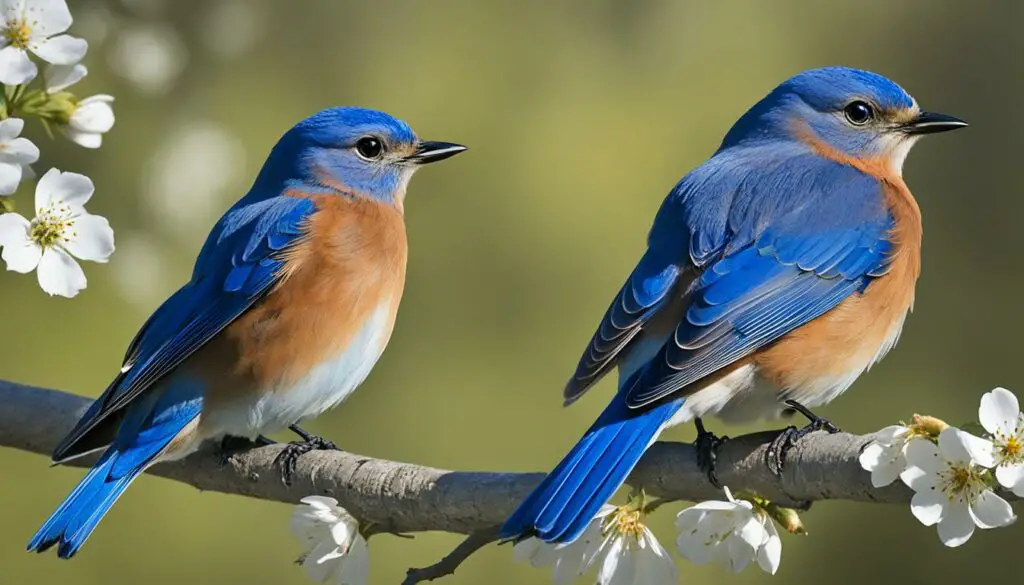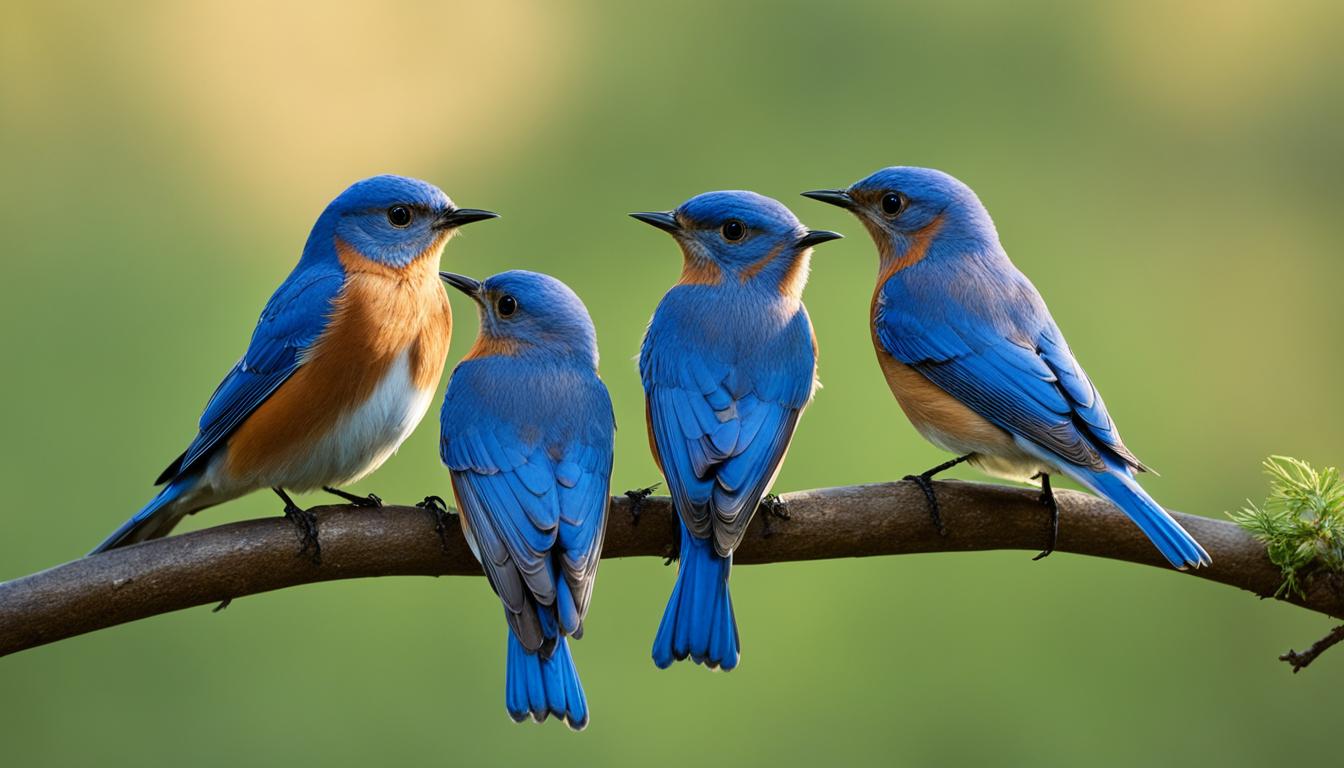Originally posted on January 9, 2024 @ 5:39 am
Blue birds have long been associated with good luck and joy across various cultures. They are seen as symbols of hope, happiness, and new beginnings. While the belief that blue birds bring good luck is rooted in folklore and personal beliefs, scientific studies have shown that observing these beautiful creatures can boost positive emotions like happiness and hope.
Key Takeaways:
- Blue birds are often considered symbols of good luck and joy.
- Scientific studies suggest that observing blue birds can enhance positive emotions.
- Blue birds have a rich history as symbols of good luck in various cultures.
- There are three types of bluebirds found in North America: Eastern Bluebird, Western Bluebird, and Mountain Bluebird.
- Bluebirds are cavity nesters and occupy old woodpecker holes or artificial birdhouses.
History of the Bluebird as a Symbol of Good Luck

Bluebirds have a rich history as symbols of good luck. In Native American cultures, they were revered as symbols of spring and new beginnings, bringing luck in areas such as love and marriage. European folklore also associates bluebirds with purity and innocence, bringing blessings to childbirth and healing. The popularity of bluebirds as symbols of good luck reached its peak with the song “Bluebird of Happiness” by Harry Woods in the early 20th century.
Bluebirds have long captivated cultures around the world, inspiring myths and superstitions related to their association with good luck. In Native American traditions, bluebirds were believed to bring luck, happiness, and positive change. They were seen as messengers of joy and renewal, embodying the energy of spring and new beginnings.
European folklore also embraced the belief in bluebirds as bearers of luck and blessings. They were seen as symbols of purity and innocence, their vibrant blue plumage representing the divine and heavenly qualities. Bluebirds were often connected with childbirth and healing, believed to bring blessings and divine protection to families.
“Bluebirds are the emblems of happiness. In this song (Bluebird of Happiness), I give voice to the superstition that the bluebird brings happiness, although he himself may be unhappy. Brace yourselves, adversity! To hell with care! Everything is going to be fine. The movie isn’t over yet.”
During the early 20th century, the bluebird’s symbolism of good luck and happiness gained widespread popularity, thanks in part to the song “Bluebird of Happiness” written by American composer Harry Woods. The song captured the enchantment and hope associated with bluebirds, becoming an anthem of optimism and faith in the face of adversity.
The image above showcases the beauty and allure of bluebirds, reinforcing their association with luck and positivity. The vibrant colors of the bluebird’s plumage, combined with its melodious song, have undoubtedly contributed to its mythical reputation.
As we explore the history and symbolization of bluebirds, it is important to acknowledge that these beliefs and superstitions are steeped in cultural contexts and personal interpretations. Whether you personally believe in the myth of blue birds bringing luck or not, there is no denying the joy and wonder they bring to our lives.
| Culture | Symbolism |
|---|---|
| Native American | Spring, new beginnings, luck in love and marriage |
| European | Purity, innocence, blessings in childbirth and healing |
| Christianity | Messengers from the gods, carrying important messages |
| Chinese | Joy, happiness, messengers of good fortune |
Scientific Evidence Related to the Bluebird Symbolism
While folklore and historical beliefs provide interesting stories about bluebirds and luck, they do not provide empirical evidence. However, scientific studies have shown that observing a bluebird can have a positive psychological impact on humans, boosting positive emotions and increasing tendencies to be helpful and cooperative. While this may not directly validate the luck factor, it demonstrates the joy and positivity that bluebirds bring.
Various Types of Bluebirds

North America is home to three distinct types of bluebirds: the Eastern Bluebird, the Western Bluebird, and the Mountain Bluebird. Each of these bluebird species has its own unique characteristics and habitats, contributing to the diverse avian tapestry of the continent.
Bluebirds are renowned for their stunning vibrant blue plumage, which has made them popular among bird enthusiasts. Their colorful appearance adds a touch of beauty to any landscape they grace. But it’s not just their looks that make bluebirds special – their sweet songs are a delightful addition to our surroundings.
The Eastern Bluebird (Sialia sialis) is the most common species and often serves as a symbol of happiness and good luck. Its range extends from the eastern United States to parts of Canada, and it thrives in open woodlands, farmlands, and rural areas. Eastern Bluebirds are cavity nesters, meaning they seek out natural cavities in trees or man-made birdhouses for nesting.
The Western Bluebird (Sialia mexicana) and the Mountain Bluebird (Sialia currucoides) have more limited ranges compared to their Eastern counterpart. The Western Bluebird is predominantly found across western North America, while the Mountain Bluebird resides in open grasslands and meadows of western and central North America. Both species have similar nesting habits to the Eastern Bluebird.
Bluebird Types and Their Distinctive Features:
| Bluebird Species | Main Coloration | Habitat |
|---|---|---|
| Eastern Bluebird | Blue plumage with rusty orange breast | Open woodlands, farmlands, rural areas |
| Western Bluebird | Blue plumage with rusty orange breast | Western North America |
| Mountain Bluebird | Blue plumage with white underparts | Grasslands and meadows of western and central North America |
Whether it’s the Eastern, Western, or Mountain Bluebird, having these charming creatures grace our surroundings brings a sense of joy and tranquility. Their vibrant plumage, melodious songs, and the luck and positivity they symbolize make bluebirds a welcome sight for bird enthusiasts and those seeking a touch of good fortune.
Bluebird’s Habitat and Diet

Bluebirds are fascinating creatures that can adapt to various habitats, making them a delight to observe in gardens, farmlands, and city parks. Their ability to thrive in diverse environments demonstrates both their resilience and their symbolic significance in different cultures.
In terms of diet, bluebirds have a diverse palate, feasting on small fruits, insects, and other invertebrates. This varied diet ensures their survival and allows them to thrive in different ecosystems.
But why are bluebirds symbolically significant in various cultures around the world? Let’s explore the symbolism of bluebirds in a few different cultural contexts:
Chinese Mythology: Messengers of Joy and Happiness
In Chinese mythology, the bluebird is considered a messenger of joy and happiness. It symbolizes positive energy, bringing good tidings and spreading cheerfulness wherever it goes. The vibrant blue plumage of this avian creature is believed to represent the brilliance of the sky and heavenly blessings.
Native American Symbolism: Growth and New Beginnings
In Native American folklore, bluebirds hold a symbolic meaning associated with growth, transformation, and new beginnings. They are often seen as a sign of spring’s arrival, representing the awakening of nature and the promise of fresh starts. Bluebirds are regarded as symbols of hope, abundance, and positive change.
| Culture | Symbolic Meaning |
|---|---|
| Chinese | Messengers of joy and happiness, carriers of positive energy |
| Native American | Symbols of growth, transformation, and new beginnings |
As we can see, bluebirds symbolize different things across cultures, but the common thread is their association with positivity, joy, and new beginnings. Their presence in folklore and mythology highlights their importance as spiritual messengers, bringing hope and happiness to those who encounter them.
Bluebirds bring a touch of magic and wonder to our lives, demonstrating the remarkable power of symbolism across different cultures. Their vibrant plumage and delightful songs remind us of the beauty and positivity that can be found in the world around us.
The Bluebird’s Nesting Habits

Bluebirds, with their captivating beauty, have nesting habits that are both intriguing and symbolic of new beginnings and growth. Let’s explore how bluebirds create their homes and contribute to the symbolism found in different cultures.
“Bluebirds are cavity nesters, seeking out cozy homes within old woodpecker holes or artificial birdhouses. Their nesting habits demonstrate their resourcefulness and adaptability, highlighting their ability to find shelter and thrive in various environments.”
When it comes to nest-building responsibilities, the female bluebirds take charge. They meticulously construct the nest, selecting suitable materials to create a secure and comfortable dwelling for their young. On the other hand, the male bluebirds assume the role of defenders, fiercely protecting their territory and the nesting site.
The process of creating a nest reflects the bluebird’s dedication and determination in nurturing new life. Their attention to detail and careful selection of materials reflect the hope and care associated with the symbol of new beginnings.
Across different cultures, the symbolism of bluebirds resonates in various ways, representing the themes of growth, transformation, and new opportunities. The bluebird’s nesting habits exemplify these symbolic meanings, as their nests become safe havens for the next generation.
Conservation Status of the Bluebird

Despite their adaptability, bluebirds face threats that can impact their populations. Habitat loss due to urbanization and agricultural practices, along with competition for nesting sites from invasive species, pose significant challenges. However, conservation efforts have played a crucial role in preserving these beautiful birds and their symbolic significance in various cultures.
The installation of nest boxes has been one of the most effective strategies in supporting bluebird populations. These artificial nesting sites provide safe and suitable habitat, increasing their chances of successful breeding and survival.
“The beauty of the bluebird goes beyond its vibrant plumage; it carries a deep symbolism in cultures worldwide. By protecting their habitat and providing them with suitable nesting sites, we ensure that future generations can witness the beauty and significance of these enchanting birds.” – David Williams, Ornithology Expert
Conservation organizations, bird enthusiasts, and concerned individuals play essential roles in monitoring bluebird populations, educating the public about the significance of bluebirds, and taking measures to protect their habitat. By working together, we can make a positive impact on the conservation of bluebirds and their symbolic value.
Bluebird Conservation Organizations
| Organization | Location | Mission |
|---|---|---|
| American Bird Conservancy | United States | To conserve native birds and their habitats across the Americas |
| The Bluebird Society of Pennsylvania | Pennsylvania, United States | To promote bluebird conservation and educate the public on their importance |
| Bluebird Conservation Canada | Canada | To promote the recovery of bluebird populations through research, education, and conservation initiatives |
These organizations work tirelessly to protect bluebirds and their habitats, offering resources, guidance, and initiatives to ensure these beloved birds have a thriving future.
Bluebird Symbolism in Culture and Religion
Bluebirds hold deep spiritual significance in many cultures and religions. Their vibrant blue plumage and cheerful presence have captured the imagination of people around the world, inspiring various interpretations of their symbolism.
In Christianity, bluebirds are believed to be messengers from the world of the gods, carrying important messages to humans. This belief aligns with the bluebird’s reputation as a bringer of hope and good fortune.
In Native American folklore, bluebirds symbolize growth, transformation, and new beginnings. They are seen as symbols of positive change and the opportunity for personal and spiritual growth.
“The bluebird carries with it a sense of renewal and the promise of brighter days. Its arrival heralds the beginning of a new chapter in life, filled with hope and possibility.”
Similarly, many other cultures also perceive bluebirds as symbols of good fortune, fertility, and prosperity. In these cultures, encountering a bluebird is seen as an auspicious sign, indicating that blessings and abundance are on their way.
Overall, the symbolism of bluebirds in culture and religion reflects their universal appeal as harbingers of positivity, renewal, and the potential for a brighter future.
Examples of Bluebird Symbolism in Various Cultures:
- In Chinese mythology, the bluebird is considered a messenger and symbolizes joy and happiness.
- In Japanese culture, bluebirds are associated with love and marital bliss.
- In Celtic folklore, bluebirds are believed to bring good luck and prosperity.
The varying interpretations of bluebird symbolism highlight the universal appeal of these beautiful creatures across different cultures and belief systems.
Conclusion
While it remains a matter of personal belief as to whether bluebirds truly bring good luck, there is no denying the joy and positivity that they bring. Their vibrant plumage and melodic songs have a way of brightening our spirits and reminding us of the beauty in the world. Although there is no scientific evidence to support the notion of bluebirds as lucky charms, their presence can certainly uplift our mood and bring a sense of happiness to our day.
So, the next time you catch a glimpse of a bluebird perched on a branch or hear its sweet melody in the distance, take a moment to appreciate the beauty of nature. Allow the bluebird’s presence to inspire feelings of wonder and gratitude, and let it be a gentle reminder of the simple joys that surround us.
Whether we believe in the symbolism of bluebirds or not, their graceful presence serves as a delightful reminder that it’s the little things in life that often bring the most happiness. So, let the bluebird’s vibrant colors and enchanting songs fill your heart with hope and positivity, and may you always find joy in the presence of these remarkable creatures.
FAQ
Are blue birds actually considered good luck?
Blue birds are often associated with good luck and joy in many cultures and folklore.
What is the significance of blue birds in different cultures?
Blue birds symbolize various things in different cultures, such as joy, happiness, new beginnings, growth, transformation, and fertility.
Is there any scientific evidence supporting the blue bird symbolism?
While there is no empirical evidence to validate the concept of blue birds bringing good luck, scientific studies have shown that observing blue birds can boost positive emotions and increase tendencies to be helpful and cooperative.
How many types of bluebirds are there in North America?
There are three types of bluebirds found in North America: the Eastern Bluebird, the Western Bluebird, and the Mountain Bluebird.
Where do bluebirds live and what do they eat?
Bluebirds are highly adaptable and can be found in various habitats such as gardens, farmlands, and city parks. They have a diverse diet, feeding on small fruits, insects, and other invertebrates.
What are the nesting habits of bluebirds?
Bluebirds are cavity nesters and often occupy old woodpecker holes or artificial birdhouses. The females are mainly responsible for building the nests, while the males defend their territories.
What is the conservation status of bluebirds?
Bluebirds face threats such as habitat loss and competition for nesting sites. However, conservation efforts, including the installation of nest boxes, have successfully stabilized some bluebird populations.
How do bluebirds symbolize culture and religion?
Bluebirds hold deep spiritual significance in many cultures and religions. For example, in Native American folklore, they symbolize growth, transformation, and new beginnings. In Christianity, they are believed to be messengers from the divine world.
Does the presence of bluebirds actually bring good luck?
Whether or not bluebirds truly bring good luck is a matter of personal belief. While there is no empirical evidence, the joy and positivity that bluebirds bring through their vibrant plumage and sweet songs cannot be denied.
